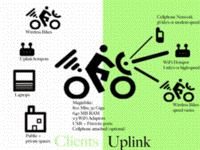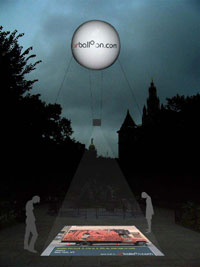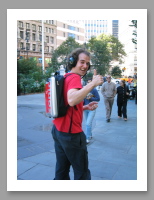 LO TECH LOCATION:
LO TECH LOCATION:TWO FROM THE 'SPECTROPOLIS' OEUVRE
BY: Molly Hankwitz
An inspiring exhibition of city and mobile media, wireless art was NYC's Spectropolis 2004 festival/exhibition curated by Wayne Ashley of the Lower Manhattan Cultural Council which brought together art exploring especially, new modes of networked delivery in the city where wireless and urban space collide. The following two projects demonstrate 'location' in relation to the possibilities of mobile media to bring networked communication, free speech and free access to public space.
'Magicbike' by Yury Gitman is a fine example of network art that employs wireless to take us to new heights of public space. Gitman an activist with Critical Mass and an artist who has been working with wifi in parks and public spaces, rigs bikes with wifi transponders effectively creating a localized 'ad hoc' network of internet access nodes capable of moving to just about anywhere. On Dec 13, 2003 for the first time ever, email was sent and web pages were made on the platforms of the N, R, Q, and W trains of the New York City subway system. In an effort to bring attention to the need for free Internet throughout the train system and the city, the first messages were sent to Mayor Michael Bloomberg from 'platforms two levels beneath the street' (NYTimes,Dec. 15, 2003).
'Magicbike'is a mobile WiFi hotspot that gives free internet connectivity wherever its ridden or parked. Magicbike explores new delivery and use strategies for wireless networks by disappearing into the urban fabric and bringing Internet to yet unserved spaces and communities. It is perfect for setting up adhoc Internet connectivity for art and culture events, emergency access, public demonstrations, and communities on the struggling end of the digital-divide.-Yury Gitman
Gitman won the Ars Electronica Golden Nica award for Net Vision in 2003 for his game 'Noderunner'- a narrative about two wi fi nodes trying to find each other and is a co-founder of the city-wide wireless festival and mobile media exhibition, 'Spectropolis 2004
 'Urballoon' by Carlos J. Gomez de Llarena, was trialed first at 'Spectropolis 2004' as an installation project - an 'urban media space' which 'aims to create a parallel experience between the urban and information spaces' in the form of a large balloon equipped with data projector and wireless connection enabling audience to both view on the street and submit content online for remote 'broadcast' in public space. Installed at various locations throughout the festival, the balloon floated approximately 12 meters above on tethers and projected directly beneath onto the street or sidewalk. Messages and images posted to http://www.urballoon.com are archived and can be browsed.
'Urballoon' by Carlos J. Gomez de Llarena, was trialed first at 'Spectropolis 2004' as an installation project - an 'urban media space' which 'aims to create a parallel experience between the urban and information spaces' in the form of a large balloon equipped with data projector and wireless connection enabling audience to both view on the street and submit content online for remote 'broadcast' in public space. Installed at various locations throughout the festival, the balloon floated approximately 12 meters above on tethers and projected directly beneath onto the street or sidewalk. Messages and images posted to http://www.urballoon.com are archived and can be browsed. Large balloons conjure up images and associations with visionary travel, blimps and scientific weather measure. They are fundamenatally, like signal-based communication, about 'air'. Urballoon refers to 'airwaves' and the manner by which 'data' has been, is, or is not delivered. The sphere of the globe displaying the project's URL, becomes a site in physical and digital contexts; one for 'free, uncensored speech', empowering citizens to 'sieze' that space as an urban broadcasting channel.' It is a project which fundamentally addresses the ability of new technologies to transcend the idea that news, information, art or ideas need to be 'location-based' and in this sense redresses what 'public' is, could be, and how we deploy it today.

Spectropolis 2004